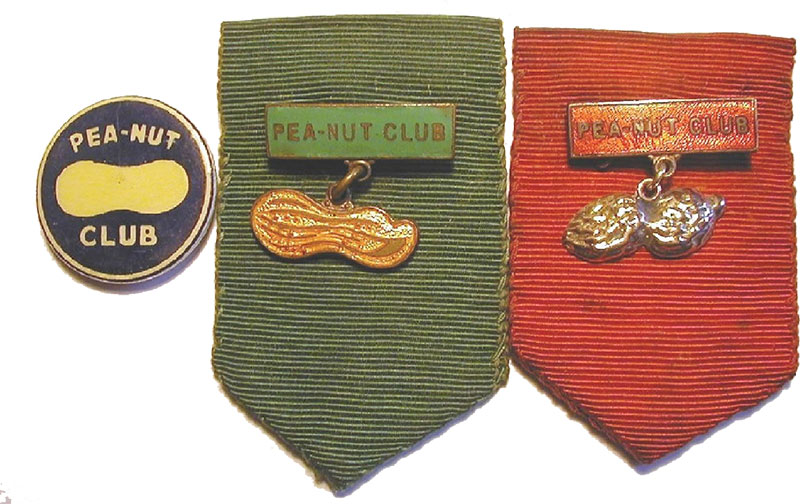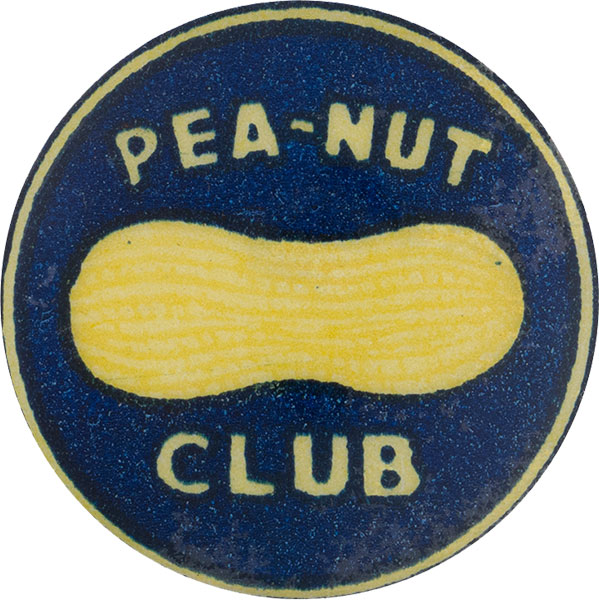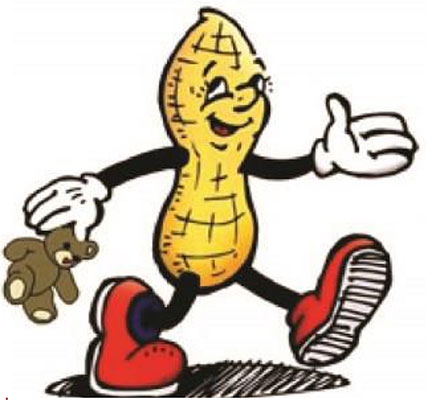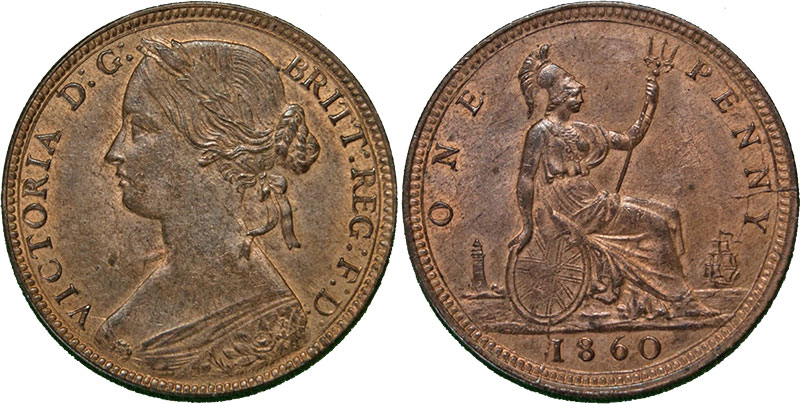Introduction
This page was started because of an email that Ken Booth sent me in July 2001. This was followed by an email from John and Carol Chamley, who collect badges, in October 2004.
Ken's email was used as part of the page about the crew of HMS Gambia and in it he said that...
I did have a strong connection with Peanut, it being the Peanut Club, started during the WW2 to support Sir Archibald McIndoe, the Plastic Surgeon who rebuilt the faces etc. of servicemen burnt in action. The badges that I sold for one shilling were small yellow discs with an unshelled peanut on it. I sold hundreds of these on many ships and in pubs all over the place. It was a crime to be found without your badge on you, so much so that when you went for a shower the lads would keep them in their mouths! After selling so many hundred I would get a Peanut Medal, this was a peanut hanging on a bar on a ribbon, there were five different colours of ribbon until you got to the top which was a Gold peanut, which I still have. I also like peanut butter!!

Peanut Club badge and medals
Photo courtesy of Ken Booth
Following the email from John and Carol, asking about the Peanut Club, I decided to do a little research into both it and the Guinea Pig Club.
The Peanut Club

Peanut Club badge
Photo courtesy of John and Carol Chamley
The original Queen Victoria Hospital NHS Trust website said that funding for the Kent and Sussex Hospital was started in 1931 when Mrs. Gordon Clemetson, writing as "Aunt Agatha", started the Peanut Club, the children's section of a local newspaper. Mrs. Clemetson promised a bag of peanuts to anyone giving 12 new pennies to the Hospital Fund.
This would have been around the same time as groundwork was started for the present Queen Victoria Hospital. This hospital replaced two previous cottage hospitals and was opened in 1936.
J. P. Bennett's "A History of the Queen Victoria Hospital, East Grinstead" says that...
The hospital had long needed a children’s ward and the money for this project had been raised by the Peanut Club. This curious and typically British affair had been born in 1931 in connection with a special appeal which was being held in Tunbridge Wells to raise money for the new Kent and Sussex Hospital. A comic newspaper called "Glad Rag" was produced by journalists. Mrs Clemetson wrote in this paper an intended parody on a children’s feature called the Peanut Club, offering a bag of peanuts to anyone who gave twelve 1931 pennies to the hospital funds. She signed the piece "Your adoring Aunt Agatha". To everyone’s astonishment a little girl presented herself together with twelve pennies at a local bank and demanded a bag of peanuts. It was quickly realised that if one child had taken the suggestion seriously no doubt many more would do the same. Within 7 years £14,000 had been raised for the Tunbridge Wells Hospital and McIndoe [Sir Archibald Mclndoe], seeing the possibilities, asked Aunt Agatha, about raising funds for a children’s ward.
Jean Rice, writing in Ireland GenWeb in February 2003, gives an account of the Peanut Club, written by Miss M. C. L. Longley of Tunbridge Wells, Kent in June 1998. Apparently the Peanut club was started as a sort of joke as the article says that...
Local journalists produced a fun paper at a special event to raise money for the Kent & Sussex Hospital, Tunbridge Wells. One young journalist, signing herself "Aunt Agatha," promised a bag of peanuts to any child who donated a dozen "Bun" pennies to the cause (a "bun" penny was one bearing Queen Victoria when she wore her hair in a bun). One child did just that, so Mr. W. R. Murray, Managing Director of the "Kent and Sussex Courier," decided others could do the same and so the Pea-Nut Club was born. Miss Longley was a made a member (no. 2087) in April 1932. Every week for many years "Aunt Agatha" wrote a letter to the children of the Pea-Nut Club in the "Kent and Sussex Courier."
"Aunt Agatha" went on to become Mrs. Gordon Clemetson, Editor-in-Chief of the same paper. To celebrate £25,000 being raised for the Kent & Sussex Hospital since the club began in May 1930, a Service of Thanksgiving was held in Christ Church, Tunbridge Wells, on 6th September 1942. So many people were expected to want to attend that it had to be by ticket only. Not only did children become members, but also their relatives, friends and pets - in fact anyone and anything so long as the membership money was paid!
Miss Longley's father made his bicycle a member, calling it "Old Faithful" as he used it day and night to get him to and from work. HMS Revenge was the first ship to help in a big way, raising £500 to buy a hospital cot. Several RAF Squadrons also joined. Eventually the club became so large that it it had to have two paid staff. At one time the Pea-Nut Club kept the "Magic Cupboard" on the children's ward stocked with books, puzzles, games, etc., and when child patients were discharged they received a present from it. After the war Sir Archibald McIndoe asked for the interest to be revived to work for the plastic surgery unit at the East Grinstead Hospital. At one time there were at least 350,000 members all around the world.
The idea of the Peanut Club was to collect small sums of money from an enormous number of people. The club became very successful and the Peanut Club badges soon replaced the peanuts. In 1936, the club was extended to help the Queen Victoria Hospital at East Grinstead and the club has continued to provide amenities to the hospital outside the scope of the National Health Service. The Emergency Medical Service wanted to set up four specialised units around London to provide treatment for war casualties with facial injuries and burns. Sir Archibald McIndoe arrived at the QVH on 4th September 1939, to set up one of the units.
In 1947, the National Health Service was formed, and attempts were made for the money raised by the Peanut Club to be added to the general pool. These attempts were successfully repelled through the work of Sir Archibald and others. The children's unit was opened in July 1955 by the Queen Mother and christened "Peanut Ward."
As well as the ribbons awarded to Ken Booth there were other gifts and prizes. A small tankard was awarded to the child who had collected the most bun pennies in a year.
The Peanut Club is a worldwide organization, and the the attempt by the Ministry of Health to add the Peanut Club funds to the general pool sparked outrage around the world amongst their loyal members. An example can be found in the January 1952 (Volume 3, No. 10) newsletter of 458 Squadron, Royal Australian Air Force...
PEANUT CLUB
Members will recall the Peanut Club Re the organisation formed to raise money for the Queen Victoria Hospital, East Grlntead, (the plastic surgery centre in England). Gus Charlwood introduced moat of us who were with 458 at Bone and thereafter to membership of the club. The squadron raised enough money to endow a bed in the proposed children’s ward.
Subsequent developments for the fund seem to have been unhappy. Three squadron members in England (Dick Rutter, Harry Eastwood and Peter Pettit) have drawn our attention to an editorial in the London Sunday Express about the Peanut Club funds. This is too long to reproduce and, being efficient journa11em, not easy to condense, but it appears that in all £24,000 was raised for the ward and after the nationalisation of British hospitals continued to be held in trust for its original purpose of endowing the children’s ward. Now, it appears, the British Ministry of Health has claimed the money for its General Endowment Fund — from which all British hospitals are financed. The Sunday Express editorial, which is headed "Plain Robbery" includes these words about the affair:
"Money poured in … All the Services, deeply grateful for what the Hospital had done for their men gave generously. The Navy, Army and Air Force each contributed the coat a cot so did R.A.F. Squadron 458. [This is a typo in the original newspaper article, it should have been R.A.A.F.] … In 1949 it (the Peanut Club) assured the new State Management Committee that the money was still available for its original purpose whenever needed … Now, suddenly, the Trustees have received a curt letter … the letter states, without a word of thanks, gratitude or simple human understanding, that, under the National Heath Act, the money belongs to the Ministry of Health … As for the Queen Victoria’s Children’s ward, the writer of the letter adds curtly 'the cost of that, ff and when built, will be borne by the Exchequer.’
Meanwhile, the Children’s ward of the Hospital remains a temporary hut with 14 cots crushed into a space suitable only for eight, and according to one of the surgeons, in a state of dilnp1dat1on without equal in a good hospital."
The Squadron Committee in N.S.W. [New South Wales] has written to the Ministry of Health in Britain. As it is probable that not many of the other major contributors, particularly the service units, are now in a position to express their views, the Squadron may be thought to speak for the donors to the Peanut Club as a whole. This is the Letter.
The Minister of Health.
Dear Sir,
A proposal understood to emanate from your department has been brought to the attention or the Committee of this squadron that the funds collected by the "Peanut Club" organisation of the Queen Victoria Hospital, East Grinstead, England, should be compulsorily transferred to your Ministry’s General Endowment Fund.
Wartime members of this Squadron were substantial donors to the "Peanut Club" funds on the clear understanding that these funds were to be used for the endowment of a Wing of the Queen Victoria Hospital.
The Squadron Committee instructs me to inform you that Squadron members strongly object to the funds being used for other purposes than those for which they were subscribed.
The club is still going strong, providing funds for the Peanut Ward at QVH, East Grinstead. In fact, The Children's Fire and Burn Trust still raise funds and sell Christmas cards for the Peanut Ward.

A more upbeat peanut from the Peanut Assessment Unit Leaflet
Bun Pennies
Queen Victoria was born on 24th May 1819, she became Queen on 20th June 1837, and was crowned on 28th June 1838. She ruled for 63 years, until her death on 22nd January 1901, Britain's longest reigning monarch. Not surprisingly, the image of her used on coins changed several times. The "Bun" pennies were minted between 1860 and 1894 with details of the design changing several times. Some of the designs are very much more valuable today than others.

1860 "Bun" Penny
Plastic Surgery
The "plastic" in plastic surgery comes from the Greek "plastikos" which means to mould, shape or give form. Plastic surgery includes both reconstructive and aesthetic qualities. There is some evidence that there were treatments for facial injuries around 4,000 years ago. As early as 800BC doctors in India were using skin grafts for reconstructive surgery. In Virginia, in 1827, Dr. John Peter Mettauer performed the first cleft palate operation in America.
It was the terrible injuries inflicted by warfare in the late 18th and early 19th centuries that gave surgeons the impetus to find new and innovative methods of reconstructive surgery. It was the scale and seriousness of injuries inflicted during World War I that really gave surgeons on both sides of the conflict the will and resources to develop new, ingenious and specialized treatments and modern plastic surgery was born.
During this time several surgeons cam e to prominence in the field. Among them were Harold Delf Gillies, born in New Zealand and trained in Britain as an otolaryngologist (ear, nose and throat); Vilray Blair, an orthopedic (skeletal system, its joints, muscles and associated structures) surgeon from St. Louis; Robert Ivy, a general surgeon from Philadelphia; Lee Cohen, an American otolaryngologist who studied in Europe; and Varaztad Kazanjian, an American immigrant who studied dentistry at Harvard Dental School and worked on the staff at Massachusetts General Hospital.
Gillies served with the British Army and worked at a hospital in Rouen, France and was particularly interested in reconstructive surgery. Early in the WWI, he was chosen by eminent surgeon Sir Arbuthnot Lane, head of plastic surgery at the Cambridge Military Hospital, Aldershot and one of the founders of the Queen Mary’s Hospital in Sidcup, Kent, which opened in august 1917, to run the reconstructive treatment centre at the Queen’s Hospital. Gillies trained many surgeons at the hospital and was later knighted for his work.
By the end of the war, 11,572 major facial operations had taken place at Queen's Hospital. When World War II threatened, in 1939, Gillies began organizing hospitals again. The Emergency Medical Service was set up with hospitals out of London selected to deal with the anticipated problem of hundreds, if not thousands, of badly burned and injured people. One of them was the Queen Victoria Cottage Hospital, East Grinstead.
In 1930, Sir Harold's cousin and fellow New Zealander, Archibald McIndoe became clinical assistant in the Department of Plastic Surgery at St. Bartholomew’s Hospital. In 1938, McIndoe was appointed consultant in Plastic Surgery to the Royal Air Force. On the outbreak of the war in 1939, he selected the Queen Victoria Hospital at East Grinstead as his base. He specialized in the care and treatment of badly burned and injured RAF crews, and the Guinea Pig Club came into existence. In 1947 McIndoe was also knighted for his work.
The Guinea Pig Club

Guinea Pig Club logo
The club was formed in 1941 and so named because, although some of the techniques were tried during World War I, McIndoe wanted to improve on them and try new ones. By the end of the war there were 649 members of the club; 57% were British; 27% were Canadian; 8% were New Zealanders; 8% were Australian. Despite the pain and seriousness of their injuries, these men never lost their sense of humour, hence the name "The Guinea Pig Club" and in some ways this was reflected in the way it was run. As the Queen Victoria Hospital page about the club puts it, "The Secretary was a pilot with badly burned fingers, which meant he was excused from writing many letters. The Treasurer was a member whose legs were burned, this ensured he could not abscond with the funds!"
It's no wonder many servicemen contributed to the Peanut Club, J. P. Bennett's "A History of the Queen Victoria Hospital, East Grinstead" says that...
The Guinea Pig Club was born, so it is said, out of the Sunday morning hangover after a "grogging party" which most of the occupants of Ward III had earned on the night of July 9th, 1941. It was decided to form a "grogging club" the minutes of which were headed "The Maxillonian Club whose members call themselves Guinea Pigs." There were three classes of membership, Guinea Pigs (patients), Scientists (medical staff) and the Royal Society for the Prevention of Cruelty to Guinea Pigs (friends and benefactors).
The burns sustained by pilots were horrific because of the placement of the fuel tanks. Bennett goes on to say that...
The Spitfire had two fuel tanks, one above the other in front of the pilot: the top tank held 48 gallons and the bottom one 37 gallons. If a Spitfire caught fire the pilot had little chance of survival unless he could get clear in a matter of seconds. The Hurricane had 33 gallon tanks in the wings, one on each side of the centre section, and a reserve tank behind the instrument board holding 28 gallons. When a wing tank in the Hurricane caught fire the flames swept into the cockpit and the reserve tank eventually blew up.
Bennett goes to on say that more than 20,000 men of the RAF had been "incinerated" during the war. It is perhaps fitting that Queen Victoria Hospital has rest areas named after some famous, and for many of their pilots and groundcrew infamous, planes such as the Spitfire Restaurant, Hurricane Café and Lancaster Lounge.
Sources
Several of the original sources have disappeared since this page was first written. Where possible, I have linked to the old pages on the Internet Archive. Unfortunately many web pages do not last a year before they are moved or deleted and many entire websites barely make it to 3 three years before they are gone. If the links on these pages do not work, try searching for them in the Internet Archive.
458 Squadron, Royal Australian Air Force Newsletter, January 1952 (Volume 3, No. 10). I have also made the newsletter available here.
A History of the Queen Victoria Hospital, East Grinstead by J. P. Bennet, British Journal of Plastic Surgery (1988). 41, 422-44. I have also made the paper available here.
Czech Guinea Pig Members
East Grinstead Museum - links to articles about Queen Victoria Hospital
East Grinstead Museum Facebook Page - Image of a tankard awarded to the child who had collected the most bun pennies in a year.
Ireland GenWeb - This is an archive now held on the main GenWeb pages as the original has now disappeared.
Peanut Assessment Unit Leaflet - This is the leaflet with the more upbeat Peanut logo
Queen Victoria Hospital Heritage - A very short history ofthe hospital but some fantastic links to more.
Queen Victoria Hospital: Guinea Pig Club (Internet Archive)
Queen Victoria Hospital NHS Trust (Internet Archive)
This page created November 6, 2004; last modified July 15, 2020




